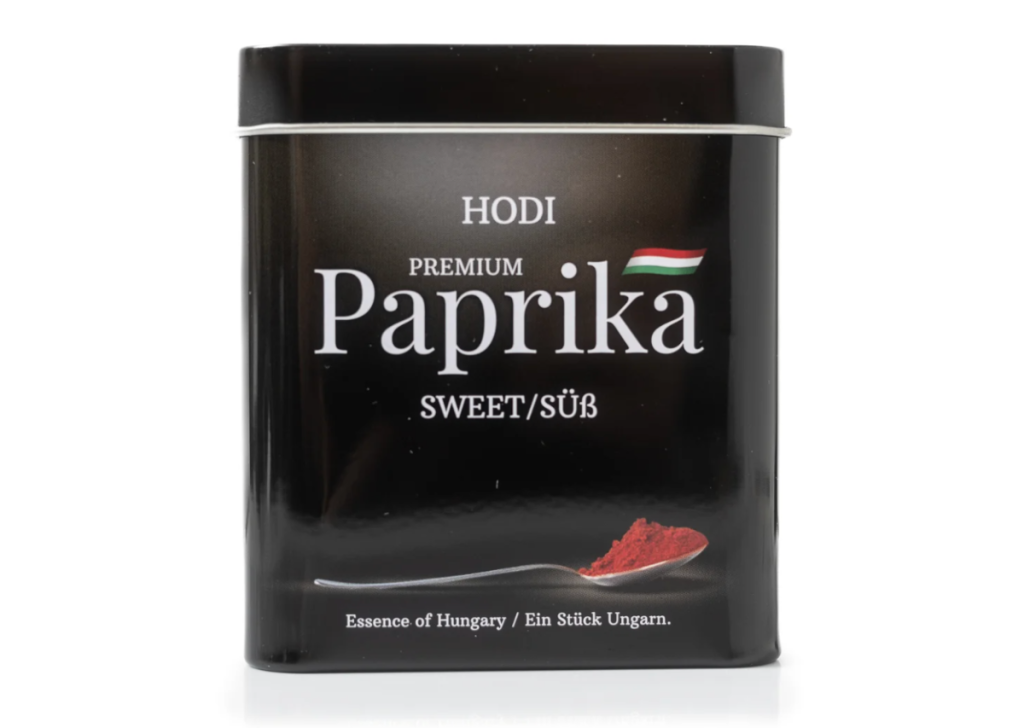Excerpt from Ari’s Top 5 enews
A new arrival in Ann Arbor from the south of Hungary
I’m excited to say that, after many months of waiting (pandemic-induced ordering issues, etc.), we’ve just received a new shipment of farmstead Hungarian paprika at the Deli. It comes to us from the Hodi family in the paprika-producing region of Szeged in the south of the country. Frank and Amy from the Bakehouse and I visited them nearly 15 years ago now on our first visit to Hungary to begin learning about the food and baking of the country that, all these years later, has led to a whole range of wonderful offerings like Dobos Torta, Esterházy Torta, Lángos, Flodni, Kifli, and the super tasty sweet bread, Somodi Kalács!
The Hodis, to my knowledge, are one of the only family producers left that has enough size and volume for us to get hold of their product, but are still small enough that they process all their own peppers. They grow the peppers, ripen them fully in the field, dry them, and stone grind them to make the paprika powder which they then hand pack. The flavor is fantastic—far fuller and livelier than the standard commercial “Hungarian paprika” which is sold in this country. (Many food folks in Hungary swear to me with great certainty that the popular brands of “Hungarian paprika” on the world market are NOT truly of Hungarian origin.) What we get is the highest grade available—Különleges (meaning “extraordinary” or “special”) paprika. Visually, it is a dark fiery red, it has an unsurpassable aroma, and an eye-opening pungency and depth of flavor. It’s not hot, but it is hugely flavorful!
Chile peppers, of course, came to Hungary from the Western Hemisphere. Paprika is often referred to by culinary historians as the “first democratic spice”—it was taken up first by poor Hungarians in rural areas, who adopted it primarily because they couldn’t afford the more expensive options (like black pepper, nutmeg, or cinnamon) that were so highly prized by upper-class cooks. Starting with the peasantry, paprika worked its way “up” through society until, eventually, it was adopted by the Hungarian nobility that had originally ignored its arrival. It’s been an essential ingredient in Hungarian cooking of all sorts ever since. After 1945, landowners were forced by the Communist government into coops and fresh produce was not allowed to be sold directly at farm markets. The small producers of paprika disappeared or went “underground.” When we visited Mr. and Mrs. Hodi, they told us stories about farmers coming to the market back then with matchboxes filled with paprika. People would pass the packet discreetly to potential customers who could sample it by smell or a small taste from the tip of their finger and then place an order to be delivered discreetly at a later date.
There’s a Hungarian saying that “one who has salt and paprika has all the spices necessary.” Paprika is ubiquitous in Hungarian cookery, used to add flavor, color, and depth to all sorts of dishes. Fish dishes, on meat, poultry, with potatoes, mushrooms, soup, and stews. “Every restaurant in Hungary, you see it on the table,” one Hungarian related to us during that initial visit. “But,” she added, “you may not see black pepper.” To give you a sense of how important it is, the average Hungarian family consumes about a kilo of paprika a year.
The Hungarian product is very particular, and not really interchangeable with the also wonderful paprikas of Spain. Its deep aroma and complex flavor are completely different, almost meaty in its taste. Without it, it’s impossible to do authentic Hungarian cooking. To release the full flavor of the paprika, you need to add it to hot fat, (not too hot though, or the sugars in the paprika will burn). Without the heat, the full flavor of the paprika won’t be realized. Take note that paprika is also added at the end of the cooking and at the table, not just in the recipe preparation. On an even simpler level, you can put Hungarian paprika on potatoes, rice, fried eggs, toast, or salad. Sprinkle it onto deviled eggs or omelets, or onto pasta dishes. I’ve taken to leaving a tin on my table so that I can add it at will. Per the great George Lang, Hungarian paprika is a “very special flavor.”



